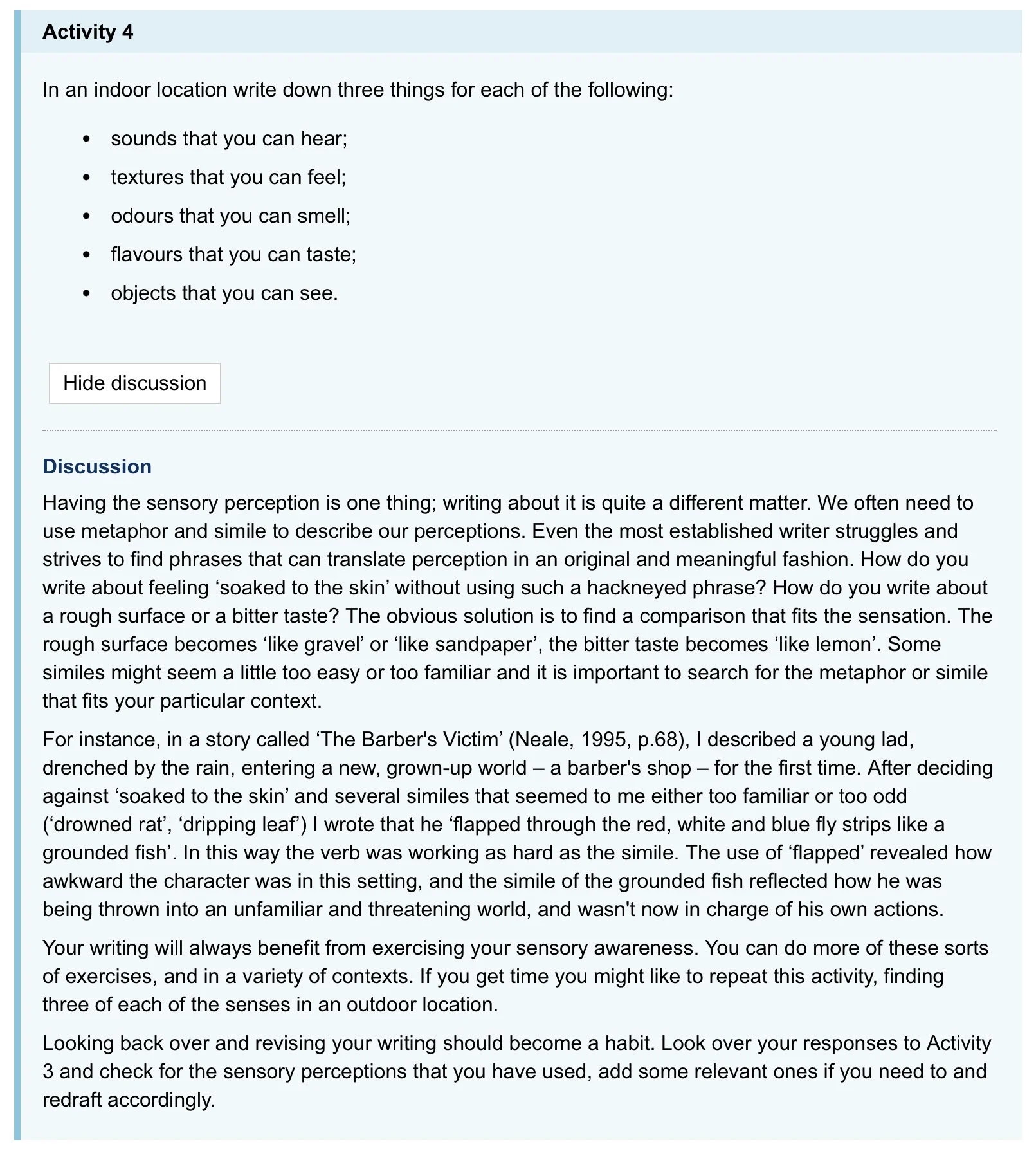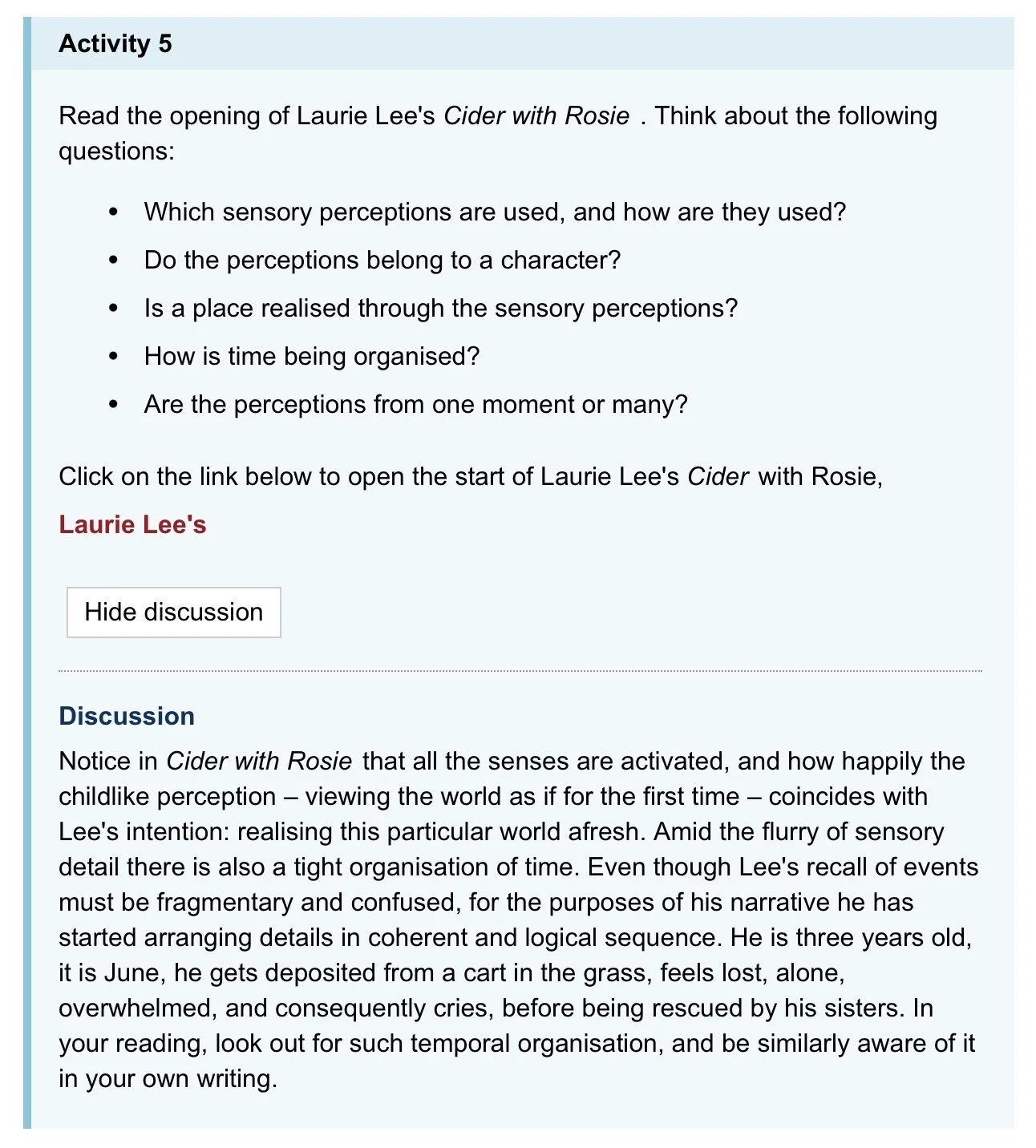3.1 Involving all of the senses
The course website describes how:
Becoming more aware of the everyday world around you involves more than just looking. If writing is a perceptual art then perception should involve all of the senses, not just the visual. You must also start to smell, feel, taste and hear the world you are trying to realise. So, in the made up scenario, when you see the man with the Scottie dog you might be too fearful to stroke his dog, but perhaps you could touch the cold metal bar where the dog was tied up – after he is gone, of course! You might feel the rough bark of the tree close at hand, smell the brash perfume of the washing detergent steaming out of the nearby launderette, taste the bitter dryness this causes in your mouth, and hear the wind whistle past the buildings. You might see the graffiti on the wall and appreciate that part of the street is always quiet, not even any traffic, and that there is a different smell: ammonia, it smells like fish.
By awakening your senses and becoming more conscious of the world around you, you will be enriching your grasp of that world. Once this heightened way of perceiving your environment has trickled down into your writing, your reader will benefit, getting a much fuller picture of the worlds you are creating.
Activity 4
In an indoor location write down three things for each of the following:
sounds that you can hear;
textures that you can feel;
odours that you can smell;
flavours that you can taste;
objects that you can see.
Location: White Rock Starbucks @ 19:07 on September 2, 2024.
Three sounds that I can hear include: 1) a young man and woman talking giddily behind me about photos on her phone; 2) the sound of a barista using a steam wand to make some kind of hot beverage, the sound of the barista washing a metal container used to make the drink, and the sound of the barista banging the little thing used to put the coffee grounds into; 3) the music playing in the cafe - Shazam tells me the song is by Stephen Sanchez, Send My Heart With a Kiss.
Three textures I can feel include: 1) the hard plastic of my ipad’s keyboard - it’s not completely smooth, it has a slightly rough texture, a smooth roughness to it; 2) the smooth polished surface of the brown countertop I’m at - my hands occasionally rub over it; 3) the relatively soft paper of the napkin that I lift to my face to wipe up a bit of tea that spilled from the cup onto my chin.
Three odours I can smell include: 1) the smell of the apple cinnamon croissant that’s been warmed in the cafe’s oven by a barista; 2) the cool crisp air behind me coming from the outside as people come in and out of the cafe; 3) the perfume a young woman near me has on.
Location: White Rock Starbucks @ 17:00 on September 13, 2024.
Three flavours I can taste include: 1) the rooty, crunchy and hard surface texture of the almonds as I bite into them with my teeth, feeling them breakout like shards of rocks across my tongue; 2) The Iced English Breakfast tea I’m drinking has a cold feel to it’s slightly bitter, malty flavour; 3) I’m also sipping a hot English Breakfast tea with 2% milk and the milk softens the bitterness of the tea which is still stronger than my iced tea because the teabag is still inside the drink itself.
Three objects I can see include: 1) the blue flashing cursor on my iPad screen, as I type into my SquareSpace journal to complete this assignment; 2) there’s a young woman standing across from me waiting for her order and she’s wearing black beats earphones, the beat logo is red… her hair is tied into a pony tail, it hangs down past her shoulders… she has white sweatpants on and a black shirt, the shirt covers her right shoulder but hangs down revealing her left shoulder and a black bra strap is visible because of this… she is talking to an older man, most likely her father; 3) my Bob Ross backpack, Ross is upside down from where I am sitting but his eyes are bright, his smile inviting me to want to paint alongside him.
I found the odour and taste prompts to be the most difficult to complete. I did google words related to the sense of taste.
3.2 Contexts
The course website notes how:
On their own, sensory perceptions don't tend to mean that much. They depend on a context in which they can be brought to life: for instance, that of a character. Such sensory perceptions as you've just listed in Activity 4 might hold more meaning if the man who twitches the curtains was the character smelling the smells or touching the surfaces; if his neighbour in the purple sari was the character hearing the noises, tasting the flavours. Sensory perceptions offer dimensions that will enrich your writing, but generally they cannot operate in isolation.
Activity 5
Read the opening of Laurie Lee's Cider with Rosie . Think about the following questions:
Which sensory perceptions are used, and how are they used?
Do the perceptions belong to a character?
Is a place realised through the sensory perceptions?
How is time being organised?
Are the perceptions from one moment or many?
Click here to open the start of Laurie Lee's ‘Cider with Rosie.’
Lee begins by referencing a kind of psychic sixth sense, describing how the main character felt “…a sense of bewilderment and terror…” even at the young age of three. By providing a visual description in the second paragraph, Lee is able to describe the claustrophobia associated with being so small amongst tall grass that “towered above me and all around me, each blade tattooed with tiger-skins of sunlight… I was lost and didn’t know where to move.” Next Lee describes the feeling sensation of the heat coming from the ground as well as the odours of the soil the young boy stands on. This bleeds into the visual, olfactory, and tactile descriptions of seeing elder-blossoms, which hang “banked in the sky,” and shower “…fumes and flakes of their sweet and giddy suffocation.” The narrator emphasizes how he is alone in this moment, as if it’s the first time he remembers being alone in awe and bewilderment. Lee then uses visual, olfactory, oratory, and tactile senses to describe in short succession birds flying overhead; smelly plants; and the feel of insects hopping and buzzing about. He creates sound that he would be able to hear, howling, and feels the sun “…hit me smartly on the face, like a bully.” The sixth sense is again spoken to, as he describes the emotion of this situation as being a “…daylight nightmare.” There’s a visual description of his sisters “…scrambling and calling up the steep rough bank…”, where calling references what he can hear. There’s a lovely visual description of his sister’s faces, which were “…familiar, living; huge shining faces hung up like shields between me and the sky…” The feeling of unease and terror melts into an ease and maybe even a joy as the boy sees his sisters, followed by more visual details: “…with grins and white teeth (some broken)… their mouths smeared with red currants and their hands, dripping with juice.” One can almost smell the currants on the two girls. You can also feel the long brown hair of one of his sister’s who “…lifted me into her long brown hair…” and you can feel the fast uneven movement of them “…jogging down the path…” Vivid descriptions follow of their cottage, “…that stood in a half-acre of a garden on a steep bank above a lake…” Lee moves into another sequence of things found within the cottage and with this, a reader can experience each of the descriptions through their own memories and experiences of them, such as “…frogs in the cellar, mushrooms on the ceiling…” It ends with another inner revelation of not knowing where he’d been before this moment. There’s one more description of where he was at the beginning of this short excerpt, where he was “…piping loud among the buzzing jungle of that summer bank…” and a declaration of inner emotion, of how, in that moment, “…I feel, was I born… it was the beginning of a life.’
The perceptions belong to the narrator, most likely an older gentlemen who is reflecting back on the first concretely vivid moments that he can remember of arriving at a cottage that would become an important part of his life. He describes the world around him, the field and its tall grasses, the nature around him which feel all-consuming and even claustrophobic. He describes feeling more secure when his sisters appear and take him to the cottage.
A place is definitely created through the sensory descriptions that Lee uses. An almost idlyic countryside is described, one that at first can feel a bit overwhelming for this young boy but we don’t know in relation to what. Was the boy from the city? From London? We are never told as this is his first memory that he can recall.
The movement of time here is fairly a fairly brief glimpse of a specific moment from the boy’s life: the moment of first significant remembrance. It’s a short moment from being set down to his sisters running to greet him, and taking him down to the cottage where they would live. The narrator does note that this was “…in the summer of the last year of the First World War.” Which gives it a very specific placement in the larger perspective of the world. It’s also specific to the First World War, so the narrator is old enough that he has seen the Second World War as well, so at least 25-30 years or longer have passed since the narrator was the three year old first arriving at the cottage. There’s nothing more given in this specific passage to pinpoint the exact age of the narrator or the time from which the narrator is writing from - other than it’s at some point during or after the Second World War (was it even referred to the Second as it played out?).
The perceptions given are from three moments, his standing in tall grass; his meeting of his sisters; and arriving at the cottage.

